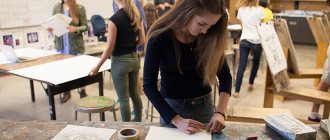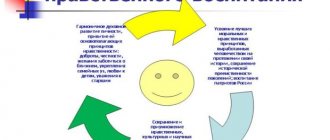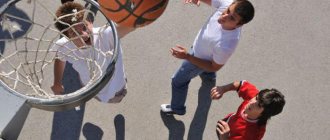Training for teenagers and parents “The path of understanding and trust”
author: Sagaiduk Alesya Vladimirovna
teacher-psychologist Municipal budgetary educational institution of the Kuibyshev region “Secondary school No. 6”
Training for teenagers and parents “The path of understanding and trust”
Training for teenagers and parents
"The path of understanding and trust"
Purpose of the training:
- promote the establishment and development of partnerships and cooperation between the parent and the child.
Tasks:
— create conditions in a practical lesson for interaction and cooperation between children and parents in gaming situations;
— contribute to expanding understanding of the psychological characteristics of the child;
— enhance effective communication within the family;
- improve emotional contact and interaction between parent and child;
— help parents understand the causes of negative behavioral manifestations in the child (rudeness, uncontrolled behavior, aggressiveness, intolerance to criticism);
The training is designed for parents and teenagers aged 10-14 years.
Group of participants 14-16 people.
Logistics:
chairs according to the number of group members, paper, pencils, a box (box with a slot) for answer sheets, paints, felt-tip pens, a ball of yarn, sheets of A4 paper, sets of colored pencils according to the number of pairs, tape or buttons for attaching drawings, a tape recorder and a cassette with recording of calm music, tables according to the number of parent-child pairs.
Expected results:
Upon completion of the lesson, parents begin to perceive their child more positively and are more willing to overcome their educational stereotypes. Emotional openness increases. Emotional disturbances in children (increased shyness, fear of failure, etc.) are easier to overcome.
Psychologist: Dear children and parents, I am very glad to see you all here, I think that our meeting today will be interesting and unusual in the form of a training that I called “The Path of Understanding and Trust.” I hope that today, thanks to my and your efforts, you will become a little closer to each other, you will begin to understand and trust each other even better. And to begin with, since perhaps not everyone knows each other well yet, I suggest you stand in two circles (outer and inner), facing each other.
- Exercise "Deer"
“Have you ever seen how deer say hello? Want to know how they do it? It’s a whole ritual: you rub your right ear against your partner’s right ear, then your left ear against your partner’s left ear, and at the end of the greeting you need to stomp your feet!” After performing this ritual, the outer circle moves to one person and the ceremony is repeated. The movement continues until all participants “greet” each other like deer and take their starting position.
Let's take our places, sit down on the chairs.
In order for our meeting to be interesting and effective, we need to accept the rules of work, I invite each participant to express their attitude to the rules: if you agree with the rule being adopted, put your thumb up; if you disagree, put your finger down and tell us what you think , this rule does not apply to you or the group.
Sample list of rules:
- Take care of the confidentiality of group life.
- Activity. Try to participate in all exercises. 3. Only one person can speak during class. Don't interrupt! Respect each other! You can only talk in a circle, you cannot whisper with your neighbor.4. Raised hand rule. We don’t shout, if you really want to say something, raise your hands.5. We only discuss what is happening here and now.
- You can only tell other people, even loved ones, about what you yourself did or felt during the training. You cannot talk about how other group members behaved or what they said.
- Stop rule. If you are not ready to discuss this topic, then you can skip the move.
- Exercise – warm-up “Pencils”
Time: 7 min
The essence of the exercise is to hold pencils or pens, closed with caps, sandwiched between the fingers of participants standing next to each other.
First, the participants perform a preparatory task: having split into pairs, they sit opposite each other at a distance of 70–90 cm and try to hold two pencils by pressing their ends with the pads of their index fingers.
The task is given: without releasing the pencils, move your hands up and down, back and forth.
After completing the preparatory task, the group stands in a free circle (the distance between neighbors is 50–60 cm), pencils are clamped between the pads of the index fingers of the neighbors. The group, without letting go of their pencils, synchronously completes the following tasks:
- Raise your arms, lower them, return to the starting position.
- Stretch your arms forward, take them back.
- Take one step forward, two steps back, one step forward (narrowing and expanding the circle).
- Lean forward, backward, straighten up.
- Sit down, stand up.
Discussion: - Was it difficult to do this exercise?
— What actions should each participant perform so that the pencils in the circle do not fall? (clear coordination of joint actions based on non-verbal perception of each other. If each participant thinks only about his own actions, then the exercise is practically impossible. It is necessary to build your actions taking into account the movements of the partners.)
— How to establish the mutual understanding necessary for this with others, learn to “feel” another person?
As mentioned earlier, our small lesson is aimed at making you better understand each other, trust each other, and I suggest that parents transform into their children, and children into their parents.
Now you need to split into 2 teams. Parents and children .
- Exercise “The ideal parent and the ideal child” (musical accompaniment)
Time: 15 min:
Children, separately from their parents, make a list that characterizes the ideal parent.
Parents, united, make their list of characteristics of an ideal child.
After this, the lists are read out. Participants are asked to discuss whether they are such, what from the list they would like to take first in order to get closer to the image of the “Ideal parent or ideal child.”
Conclusion:
There is no IDEAL in the world, and everyone has shortcomings, but this does not make children stop loving their parents, and parents do not stop loving their children.
The exercise ends with the completed lists breaking up and the parent-child pairs hugging.
Dear parents, how often have you spoken kind words to your children and praised them for their successes? After all, a person, regardless of age, needs affection, attention, praise and, of course, love.
- Exercise “Guess who it is?”
- Children, you need to stand in a circle, close your eyes, and the parents take turns approaching you (the children) in a circle.
Your task, children, is to guess your parent. If you decide that this is his parent, he says: “I love you.” If the child is right, the couple leaves. If not, then the parents' movement continues. The exercise continues until all pairs are formed.
Those who wish can share their experiences.
- Exercise “Adult – child”.
One of the important skills in active listening
is the ability to step into another person’s shoes. Unfortunately, it happens that parents and children, for various reasons, do not want or do not know how to do this. And here you just need to imagine yourself in the place of another. Probably, each of us wanted to return to childhood, or, conversely, to grow up as quickly as possible. Now you will have this opportunity.
So,
children, you dreamed so much of independence, of freedom of action, of lifting restrictions... now you are adults.
Parents, you are probably tired of everyday life, of the hustle and bustle, of problems, so you want to be a little carefree, easy-going, to realize that your whole life is still ahead of you... Now you are children.
Say what you would do if you were an adult (parent) or a child.
Start your statements with the words: “If I were a parent, then...”, “If I were a child, then...”. We speak in a circle.
Participants share their thoughts.
- Exercise "Siamese twins"
The group is divided into pairs. Each pair joins hands so that the left hand of one participant and the right hand of the other participant are free. Each pair is invited to make some kind of craft from sheets of paper (airplane, steamship, etc.). The couple makes the craft only with their free hands.
The conditions for completing the task can be complicated:
- complete the task silently,
- one participant works with his eyes closed,
- both participants work with their eyes closed.
- Exercise. “Test Situation.”
One of the practical techniques to improve family relationships and achieve mutual understanding, which can be used in everyday life, is the previously mentioned active listening exercise.
Listening skills -
a skill needed by every person. Parents often misinterpret this term. After all, maintaining silence with difficulty and waiting for your turn to speak in response to your interlocutor’s speech does not at all mean the ability to listen. Moreover, if your interlocutor is a child who jealously defends his point of view, takes a lot of things with hostility and is ready to be offended and withdrawn at any moment.
How and when should you actively listen?
This should be done in all situations when the child is upset, has failed, is in pain, is ashamed - that is, when he has emotional problems.
As an example, consider the following common situation. The son comes home after school, throws his briefcase and shouts: “I won’t go to this school again!”
How to react correctly? What to tell a teenager? How to remain calm, especially if at this moment you yourself are tired, irritated, absorbed in your problems?
Act out this situation (in pairs).
Who wants to show their skit? (2-3 pairs).
Discussion.
To avoid a conflict situation, the parent’s goal should be an uncritical assessment of what is happening; the parent should use the rules of active listening:
- Turn to face the teenager. Eyes at the same level.
- Avoid questions, use the affirmative form of statements.
- Pause, giving the teenager time to think.
- Identify the feelings experienced by a teenager.
- Exercise "Test with transplants"
Now let’s continue our closer acquaintance, and for this I propose to participate in the next exercise.
I will ask you questions, name various statements, and those who agree with them will have to get up and move to another place.
- Now, those who have pets, please change seats?
— Swap places, those who are interested in drawing?
- Who was born in the city.
- Who drank coffee for breakfast today?
— Swap places, those who love music?
“Now, those whose children are in high school, move over.”
- Those who have a family with many children, change seats.
- Who likes ice cream?
— Who works as a teacher in a school or kindergarten?
- Who regrets that the salary is so small?
- Swap places, those who are waiting - can’t wait for vacation, holidays?
- Exercise: The People I Need
We all, to one degree or another, need what other people provide us: certain services, goods, emotional intimacy, exchange of experiences, etc. Sometimes we imagine that we need someone to achieve a goal, but in fact we could do just fine on our own. In other cases, we really need someone, because the relevant “goods” are important to us and we are not able to obtain them on our own, and emotional relationships can only be established between at least two people.
Next exercise “The people I need”
, I would like to use this exercise to give you the opportunity to realize what kind of people you really need. Each of us deals with many people who are important to us to varying degrees. I need some people rarely, some often, and I need only one person all the time: myself.
I have prepared a worksheet for you to fill out. You have 10 minutes to do this. Materials:
Worksheet “The people I need”
Appendix 1
Instructions:
Summarizing:
- Was it easy for you to identify six main groups?
- Am I getting from people in categories that are important to me what I want from them?
- What values does each of the six categories I have chosen correspond to?
- How do I cope with situations when there are no people or categories of people that are significant to me?
- Can I be alone sometimes?
- What is the most important thing I need in life?
Conclusion:
Make sure your teens have a clear understanding of what values each group of people symbolizes to them.
- Exercise "Island".
Equipment: two sheets of newspaper, glued with tape.
Instructions: imagine that there has been a shipwreck, and you are the surviving passengers of the ship. In front of you is a small island, literally the size of a newspaper, I’ll put it on the floor now. Very interesting, can you stay on this island?
Note for the leader: at the beginning of the game, the newspaper freely accommodates all participants. After the group has easily positioned itself on the newspaper, the presenter says: “Very good! But there was a flood, and the island shrank - the newspaper folded in half. What will you do now? You can’t tear or move the newspaper.” Then the newspaper is folded into four, etc.
- Exercise 6 (5-7 min): “Letter of Love”
Goal: Forming a feeling of closeness, increasing a positive attitude, acquiring resource capabilities.
Divide the participants into 2 teams (parents and children), ask each team to write (or draw) a “Letter of Love” (in the end you get 2 letters: parents to children, children to parents) and ask them to reflect in their letters: feelings, desires, promises.
Letters are read and discussed.
- Exercise “Kind animal”
Target
: promote the unity of the children's team, teach children to understand the feelings of others, provide support and empathy.
The presenter says in a quiet, mysterious voice: Please stand in a circle and hold hands. We are one big, kind animal. Let's listen to how it breathes! Now let's breathe together! When you inhale, take a step forward, when you exhale, take a step back. Now, as you inhale, take 2 steps forward, and as you exhale, take 2 steps back. Inhale – 2 steps forward. Exhale – 2 steps back.
This is how the animal not only breathes, its big, kind heart beats just as clearly and evenly. Knock - step forward, knock - step back, etc. We all take the breath and heartbeat of this animal for ourselves.
- Reflection (5-7 min):
Purpose: Exchange of opinions, moods and feelings.
— What new did you learn today?
— What was especially difficult to accomplish?
— What were the most important, touching and maybe even funny moments today?
— What is the most important thing, in your opinion, that our meeting brought you?
ANNEX 1
Worksheet: The People I Need
Below you will find a list of different categories of people who are quite significant for the world in which we live. Read this list and please highlight those that are important to you. When you do this, put the categories you have chosen into a sequence, numbering them in descending order of importance and putting the corresponding number in brackets.
(...) Parents (...) Pilots (...) Auto mechanics (...) Bakers (...) Cleaners (...) Doctors (...) Pharmacists (...) Oil workers (...) Shoemakers (...) Salesmen (...) Football players (...) Lawyers (...) Actors (...) Musicians (...) Judges (...) Politicians (...) Priests (...) Grandparents (...) Miners (...) Police officers
(...) Cousins (...) Psychologists (...) Teachers (...) Engineers (...) Guardians (...) Livestock slaughterers (...) Nurses (...) Drivers (...) Criminal investigation officers (...) Hotel staff (...) Scientists (...) Homeless people (...) Social workers (...) Prison employees (...) Kindergarten teachers (...) Restaurant owners (...) Brothers and sisters (...) Other relatives From the sequence compiled, select the six most important categories, write them down here again and indicate what benefits the representatives of these groups provide you with. Describe the consequences you will face if these needs of yours are not met.
- ………………………………2. ………………………………3. ………………………………4. ………………………………5. ………………………………6. ………………………………
Training for teenagers and parents “The path of understanding and trust”
Benefits of courses for expectant mothers
- Convenient training options - from short but capacious individual lessons to long group lessons with the most complete theory and practice.
- The cost is affordable and starts from 2800 rubles. So that a mother with a small income can allocate funds from the family budget. Choose which format suits you - individual or in a group, and invest in your future today.
- The field of obstetrics and pediatrics does not tolerate non-professionals. At our school, classes are taught by doctors of the highest and first categories, candidates of science, practicing psychologists, and teachers from leading universities in the capital. And they all have their own experience of motherhood.
- Flexible schedule - registration for courses for mothers is carried out both on weekdays and on weekends.
- The main site of the School is located in the center of Moscow - training is not far from the Tretyakovskaya metro station. Groups are also being recruited near other metro stations. By individual agreement, home visits are possible, which is convenient for women on maternity leave.





